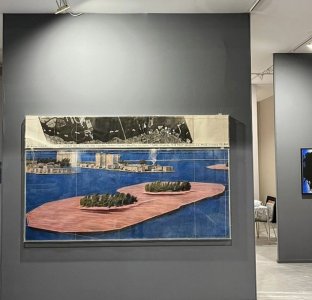Biagio.tv
in vacanza
- Registrato
- 26/3/14
- Messaggi
- 11.624
- Punti reazioni
- 632
Follow along with the video below to see how to install our site as a web app on your home screen.
Nota: This feature may not be available in some browsers.


Societe Generale rende disponibili su Borsa Italiana (SeDeX) 10 Equity Protection Certificate (con Cap) su azioni e materie prime.
Per continuare a leggere visita questo LINK

Migliora la tua strategia di trading con le preziose intuizioni dei nostri esperti su oro, materie prime, analisi tecnica, criptovalute e molto altro ancora. Iscriviti subito per partecipare gratuitamente allo Swissquote Trading Day.
Per continuare a leggere visita questo LINK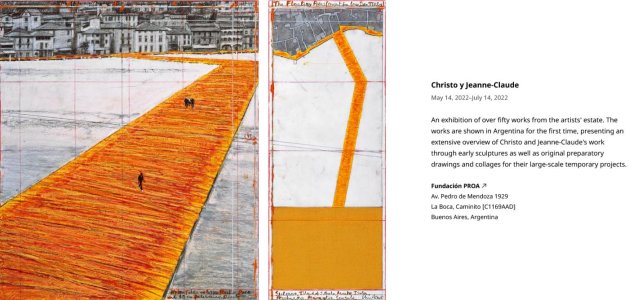

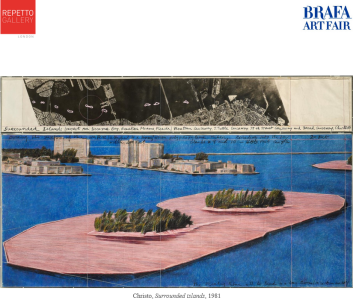
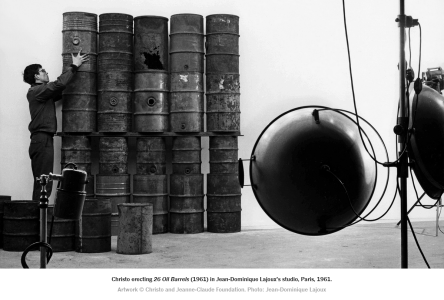
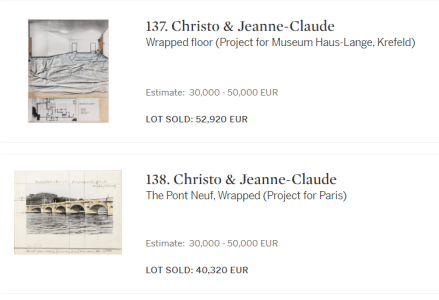

Grazie Biagio, grande notizia davvero per chi ama Christo. Vorrei sapere il tuo parere sulle tre opere storiche ( tra le quali due storici impacchettamenti) rimaste invendute qualche giorno fa da Sotheby's, in controtendenza con l'evoluzione del mercato attuale.E questa è una notiziona appena trovata: mostra di Christo da GAGOSIAN a Parigi (apre il 10 giugno 2022!)
Christo: Early Works, 1958–1963, rue de Ponthieu, Paris, June 10–October 8, 2022 | Gagosian
"My interest in Christo dates back to the mid-’70s, when I was fortunate to present an exhibition of his work in Los Angeles and to be involved with the incredible project Running Fence (Sonoma and Marin Counties, California, 1972–76), executed with Jeanne-Claude. I am thrilled now, nearly fifty years later, to partner with Christo’s estate and present his work again. These early artworks were pivotal in both the development of Christo’s vision and the history of art."
—Larry Gagosian
Gagosian Paris is pleased to announce its first exhibition dedicated to Christo, presented in collaboration with the artist’s estate. Featuring sculptures made in Paris between 1958 and 1963, many of which are being exhibited for the first time, the exhibition encompasses the earliest examples of Christo’s wrapped objects and barrel structures, together with key works from his rarely shown Surfaces d’Empaquetage and Cratères series. Opening on June 10, the exhibition unfolds across two floors of Gagosian’s rue de Ponthieu gallery, not far from Christo’s first Paris studio.
Christo moved to Paris in 1958, establishing a studio in a small maid’s room at 14 rue de Saint Sénoch in the 17th arrondissement. Here, he created his first Wrapped Objects and barrel structures, elements that became dominant in his sculptural practice. Christo found inspiration from connections with leading figures of the European and American avant-garde, including Joseph Beuys, John Cage, Nam June Paik, Pierre Restany, and Karlheinz Stockhausen. The same year, he also met Jeanne-Claude Denat de Guillebon, who became his wife and creative partner, coauthoring the monumental environmental works of art that changed the way we think of public art, and with which their names became synonymous.
"I started working on the Cratères, the Wrapped Cans, the Surfaces d’Empaquetage around the same time, in 1958. In the beginning, the wrapping was not essential. It was not so much about making an object, but more about the texture of the object itself. I used fabric to wrap the cans, then I applied paint and lacquer to stiffen the fabric. This way they became like a still life."
—Christo, 2020
The highly tactile works from the Surfaces d’Empaquetage (1958–61) series are composed with crumpled or crushed fabric or paper coated with thin layers of lacquer and sand. In 1959, after visiting an exhibition that included work by Jean Dubuffet, Christo embarked on another series, Cratères. The many thick, coagulated layers of dark brown paint characterizing these wall-mounted panels reveal his growing interest in three-dimensionality. In some, he attached empty paint cans to the base before applying a mixture of sand, enamel, and glue, creating a mesh of furrows, trenches, and depressions that penetrate the pictorial space.
Most of Christo’s first Wrapped Objects sculptures incorporate conventional art materials such as paint cans and pigment bottles, swathed in resin-soaked canvas. Enveloping everyday objects with fabric or polyethylene sheets and binding them with rope, he altered their contours and surfaces, playing with their identities which he sometimes revealed and at other times concealed. Initially the result of instinctive aesthetic experiments, the series endured for more than sixty years, informing ever larger and more complex interventions leading to the massive 2021 project L’Arc de Triomphe, Wrapped, which he first proposed in 1961.
Christo was first intrigued by steel oil drums mainly because they were big, inexpensive, and almost indestructible. He began to cover them with the same fabric, varnish, paint, and sand that he used on smaller objects like cans and bottles. While the latter works recall classical still lifes, the larger dimensions of the barrels and their arrangements into groups gave them a monumental character, prompting Christo to expand the scale of his environmental works.
Sixty years ago this month, on the evening of June 27, 1962, Christo and Jeanne-Claude installed Wall of Oil Barrels—The Iron Curtain, closing the historic rue Visconti with eighty-nine barrels. The 4.2-meter-high barricade blocked one of narrowest streets in Paris for eight hours, obstructing most of the traffic through the Left Bank. Their work with barrels will culminate in The Mastaba, conceived in 1977 for Abu Dhabi. As Christo and Jeanne-Claude’s only permanent large-scale public artwork, and also their final project, The Mastaba will be carried out per Christo’s wishes by the artist’s team.
Vedi l'allegato 2833118
Grazie Biagio, grande notizia davvero per chi ama Christo. Vorrei sapere il tuo parere sulle tre opere storiche ( tra le quali due storici impacchettamenti) rimaste invendute qualche giorno fa da Sotheby's, in controtendenza con l'evoluzione del mercato attuale.
L'asta di Martini di 3 giorni fa?? Non conta?? Mantiene il trend del Dororheum...
CondividoCiao @Cicala!
Non ho capito quanto esattamente tu conosca approfonditamente o meno Christo e il suo mercato, ma sostanzialmente stai continuando a fare il medesimo ragionamento generico sbagliando il presupposto, come se tutte le opere di un artista dovrebbero, a fronte di un aumento di quotazioni, costare tutte cifre a sei zeri... non è così!
Quello che tu definisci "trend" non è un "trend" ma sono delle singole aggiudicazioni per singoli soggetti, e tra l'altro ottime rispetto al soggetto specifico.
Per Christo nello specifico quello che fa la differenza è il soggetto (e la qualità dell'opera di quel dato soggetto). Quindi è quello che va guardato per comprendere il mercato.
Ogni singolo soggetto va quindi paragonato ai risultati precedenti per quel medesimo soggetto.
Per essere chiaro: non è che se un dittico di "Surrounded Islands" 90x75 fa 200.000 euro, un altro soggetto (Kunsthalle, Mura Aureliane, Pacco su carrello) abbia il medesimo valore.
Non funziona così!
La Kunshalle va paragonata con i valori medi precedenti rispetto ad altre Kunshalle, le Mura con altre Mura, i Pacchi con altri Pacchi, le Isole con altre Isole, i Reichstag con altri Reichstag, gli Umbrellas con altri Umbrellas etc...
Il mercato di Christo funziona così ed è sempre funzionato così: alcuni soggetti si sono storicamente comperati a meno di altri, e sarà sempre così, ma sono tutti aumentati rispetto ai valori del passato in relazione appunto al soggetto.
Grazie Biagio per la risposta sempre precisa e puntuale e grazie anche per queste meravigliose immagini!!!Tra l'altro in realtà io ero passato per il piacere di condividere alcune immagini - trovate online - della mostra di Christo da Gagosian a Parigi, che è dedicata a opere storiche realizzate tra gli anni '50 e i primi '60.
Sembra di vedere l'installazione in un museo...
Vedi l'allegato 2833615
Vedi l'allegato 2833616
Vedi l'allegato 2833619
Tra l'altro in realtà io ero passato per il piacere di condividere alcune immagini - trovate online - della mostra di Christo da Gagosian a Parigi, che è dedicata a opere storiche realizzate tra gli anni '50 e i primi '60.
Sembra di vedere l'installazione in un museo...
Vedi l'allegato 2833615
Vedi l'allegato 2833616
Vedi l'allegato 2833619
Ciao @Cicala!
Non ho capito quanto esattamente tu conosca approfonditamente o meno Christo e il suo mercato, ma sostanzialmente stai continuando a fare il medesimo ragionamento generico sbagliando il presupposto, come se tutte le opere di un artista dovrebbero, a fronte di un aumento di quotazioni, costare tutte cifre a sei zeri... non è così!
Quello che tu definisci "trend" non è un "trend" ma sono delle singole aggiudicazioni per singoli soggetti, e tra l'altro ottime rispetto al soggetto specifico.
Per Christo nello specifico quello che fa la differenza è il soggetto (e la qualità dell'opera di quel dato soggetto). Quindi è quello che va guardato per comprendere il mercato.
Ogni singolo soggetto va quindi paragonato ai risultati precedenti per quel medesimo soggetto.
Per essere chiaro: non è che se un dittico di "Surrounded Islands" 90x75 fa 200.000 euro, un altro soggetto (Kunsthalle, Mura Aureliane, Pacco su carrello) abbia il medesimo valore.
Non funziona così!
La Kunshalle va paragonata con i valori medi precedenti rispetto ad altre Kunshalle, le Mura con altre Mura, i Pacchi con altri Pacchi, le Isole con altre Isole, i Reichstag con altri Reichstag, gli Umbrellas con altri Umbrellas etc...
Il mercato di Christo funziona così ed è sempre funzionato così: alcuni soggetti si sono storicamente comperati a meno di altri, e sarà sempre così, ma sono tutti aumentati rispetto ai valori del passato in relazione appunto al soggetto.


